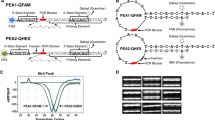Abstract
We proposed a modification the procedure of genotyping based in labeled universal primer and tailed primer. In the standard protocol, three primers are used in the same PCR reaction, a forward primer with tail added at the 5′ end of the identical sequence to labeled universal primer with dye-fluorescent and a reverse primer. Unfortunately, the choice of a labeled primer characterized by a large number of complementary sequences in target genomes (which is more probable in larger genomes) result in unspecific amplifications (false positive) can cause absence or decrease amplification of the locus of interest and also false interpretation of the analysis. However, identification of possible homologies between the primer chosen for labelling and the genome is rarely possible from the available DNA data bases. In our approach, cycling is interrupted for the addition of the labeled primer only during the final cycles, thus minimizing unspecific amplification and competition between primers, resulting in the more fidelity amplification of the target regions.



Similar content being viewed by others
References
Steffens DL, Sutter SL, Roemer SC (1993) An alternate universal forward primer for improved automated DNA sequencing of M13. Biotechniques 15:580–582
Oetting WS, Lee HK, Flanders DJ, Wiesner GL, Sellers TA, King RA (1995) Linkage analysis with multiplexed short tandem repeat polymorphisms using infrared fluorescence and M13 tailed primers. Genomics 30:450–458. doi:10.1006/geno.1995.1264
Neilan BA, Wilton AN, Jacobs D (1997) A universal procedure for primer labelling of amplicons. Nucleic Acids Res 25:2938–2939. doi:10.1093/nar/25.14.2938
Schuelke M (2000) An economic method for the fluorescent labeling of PCR fragments. Nat Biotechnol 18:233–234. doi:10.1038/72708
Sambrook J, Fritsch EF, Maniatis T (1989) Molecular cloning—a laboratory manual, 2nd edn. Cold Spring Harbor Laboratory, USA
Rozen S, Skaletsky HJ (2000) Primer 3 on the www for general users and for biologist programmers. In: Krawetz S, Misener S (eds) Bioinformatics methods and protocols: methods in molecular biology. Humana press, Totowa, pp 365–386
Abd-Elsalam KA, Aly IN, Abdel-Satar MA, Khalil MS, Verreet JA (2003) PCR identification of Fusarium genus based on nuclear ribosomal-DNA sequence data. Afr J Biotechnol 2:82–85
Van Oosterhout C, Hutchinson WF, Wills DPM, Shipley P (2004) Micro-Checker: software for identifying and correcting genotyping errors in microsatellite data. Mol Ecol Notes 4:535–538. doi:10.1111/j.1471-8286.2004.00684.x
Wu DY, Ugozzoli L, Pal BK, Wallace RB (1991) The effect of temperature and oligonucleotide primer length on the specificity and efficiency of amplification by the polymerase chain reaction. DNA Cell Biol 10:233–238. doi:10.1089/dna.1991.10.233
Singh VK, Govindarajan R, Naik S, Kumar A (2000) The effect of hairpin structure on PCR amplification efficiency. Mol Biol Today 1:67–69
Gregory TR (2005) Synergy between sequence and size in large-scale genomics. Nat Rev Genet 6:699–708. doi:10.1038/nrg1674
Acknowledgments
We are grateful to the São Paulo State Research Foundation (FAPESP) and the Brazilian National Research Council (CNPq) for their financial support.
Author information
Authors and Affiliations
Corresponding author
Rights and permissions
About this article
Cite this article
de Arruda, M.P., Gonçalves, E.C., Schneider, M.P.C. et al. An alternative genotyping method using dye-labeled universal primer to reduce unspecific amplifications. Mol Biol Rep 37, 2031–2036 (2010). https://doi.org/10.1007/s11033-009-9655-7
Received:
Accepted:
Published:
Issue Date:
DOI: https://doi.org/10.1007/s11033-009-9655-7




